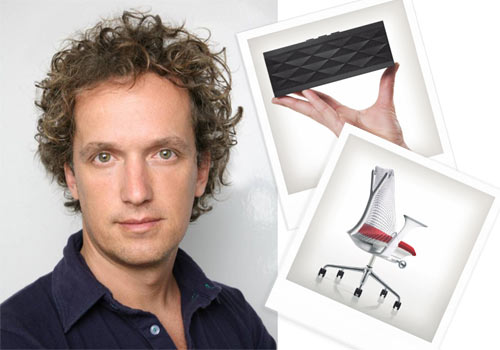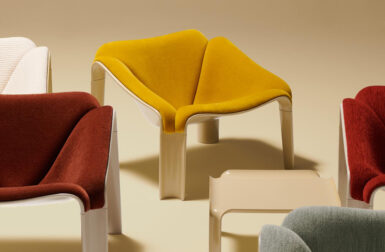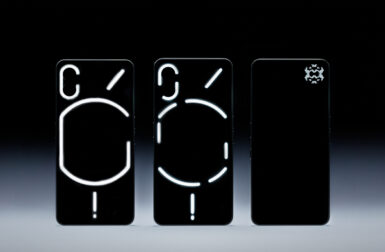This is Part 2 of My Smart Design Life, which features interviews with three designers — Chris Spooner (graphics) , Kelly Hoppen (interiors), and Yves Behar (products) — about their wired lives and how technology has shaped the way they work, supported by Intel. Read Part 1 here.
Less than 10 years ago, I dreamed of a phone that could help me organize my life and stay connected. I dreamed that blogging could be a viable career option. I dreamed about computers with touch screens. These dreams have all been realized, but now, I keep thinking, “What’s next?” Jetpacks? Flying cars? Refrigerators that do your grocery shopping for you?
I asked the same designers I interviewed in Part 1 of My Smart Design Life about where they think things are headed. What are their dream worlds like?

Yves Behar is founder of fuseproject, a San Francisco-based design firm focused on forward-thinking sustainable design focused on making our lives better — he calls it “Design for Good.” Yves notes that the responsibility of the designer is to help promote change for the better and has infused that into fuseproject’s culture. His designs have won over one hundred awards.
As designers, you are always thinking about what’s around the corner. When it comes to the technology that you use every day, what do you think is the most critical need in your field?
Chris: A stable computer that can handle the memory intensive features of the Adobe Creative Suite has to be at the top of the list for designers. There’s nothing worse than losing your work due to crashes.
Kelly: I think the portability of devices and the incredible amount that you are able to store on them has solved a lot of issues already. The fact that I can research and capture inspiration from anywhere and store it so that I can refer to it later is so liberating. Also, I can react very quickly in a client presentation or meeting to really help them articulate what it is they are after by finding and pulling up visuals from the incredible visual library I’ve built up for myself. It saves so much time!
Yves: Sustainability is enabled by new technologies, but in reverse the current state of the tech industry is completely devoid of sustainability thinking. I think the most important and critical need is a way to start bringing together advanced thinking in sustainability to the technology field.
In the next few years, what do you see your smartphone and your computer doing for you?
Chris: Hopefully they will start to do the work for me! I guess that’s a long way into the future. I’d like my computer and smartphone to simply enable me access to the web and my files and resources without needing to physically go to a certain location in my home/office.
Kelly: It will continue to free up the way we work. We can work from where-ever, whenever and connect with whomever we want to. We don’t need to be in the same place as colleges, clients or contractors… everything is virtual and it’s so easy to stay connected.
Yves: About the same they are doing now, but amplified to include context awareness and on-demand services. The real question is whether the intelligence of our devices is reality enhancing, or just reality obfuscating, this is as much a human as it is a technological issue. That said, I have a sense that what people want, and what technology will provide, is the entertainment and information we want, while keeping us engaged in the moment.

Chris Spooner is a creative designer and blogger who runs his own design business as well as a popular graphic design blog called SpoonGraphics and a web design blog called Line25.
Is there a specific technology that you’ve heard about that you are looking forward to using in your field?
Chris: Things have been slowly getting more and more wireless in the past few years, so I simply hope this continues with faster connection speeds.
Kelly: I do like the sound of Augmented Reality though I’m not 100% sure what it means. My team showed it to me on their phones where it sort of super imposes objects that are digital onto a real space. While I don’t really understand the technology, I think it could be a really powerful tool in interior design. When I enter a room I see it in terms of a sort of grid, which means I can very quickly see where things should go and how they will work together. This isn’t the case for most people but if they had a tool that they could use when standing in their room which showed them what the chair their thinking of buying would look like in the space it would save a lot of time, heartache and maybe even money. It would also be great to use with clients to help them really see my vision even more.
Yves: There are so many technologies I am excited about: interfaces that will be faster and more intuitive such as hovering touch or retinal eye tracking, displays that will be highly readable in sunlight (descendents of the OLPC screen) and micro-projectors… and probably the most exciting technology for me is the 1000kmh train being built in China that will displace air-travel for big continental trips.
What aspect of what you do, do you see becoming obsolete in the future?
Chris: Supporting certain browsers seems the obvious answer. We’re always dropping support for the older browser versions as newer, improved versions are being released.
Kelly: After a recent presentation to a client that was all on my iPad I can see with doing away with printed visualizations of rooms. There is so much more you can do when it is a digital image. You can zoom in and look at detail, fly around the room and see it from other angles… it’s amazing! I’d never give up my mood boards but I can see myself moving away from printed plans and renderings for client presentations… for builders though the printed copy will remain.
Yves: Having to explain that design is the central brand and communication device for any business. With the continuing explosion of a direct connection and dialogue between consumers and enterprises, marketing and advertising will continue to shrink in relevance. At the same time design’s everyday relevance to the consumer will expand to encompass the majority of the connection between business and the public.

Kelly Hoppen MBE is a world-renowned British interior designer who has pioneered a simple yet opulent style. She started her business at the age of just sixteen, born out of a love of interiors and has offered her talents to wallpaper, paint, furniture, print on demand artwork, home fragrance and even a collection of ethical organic clothing.
If you were going to design a device that could solve a specific problem, what would it be and what problem would it solve?
Chris: It’s not exactly a device but I’ve always longed for wireless electricity! No doubt there’s some serious flaws in the idea but not needing cables and wires would make like so much easier!
Kelly: I really want a simple home stereo system! I have had some of the best stereos installed in my homes over the years and they never ever work. I want a wireless system with pods for each room that you could easily control. It would have to look good of course but the most important thing is that it would have to be simple to operate and easy to move around. Get rid of the wires and get rid of the systems that only a rocket scientist could figure out!
Yves: So many devices are needed to solve both big human and sustainability issues in the near future: the electric car for everyone, the 1000kmh high-speed train, the simple-stupid-smart phone, the tablet One Laptop Per Child… oh wait… already working on that ;)
In terms of technology, how do you see life in 10 years? Will we be flying in space crafts? What about in 30 years?
Chris: It’s so difficult to predict because things are so different today than they were 10-30 years ago. I guess we could gain an insight by looking at the latest military technology advancements and imagine how that technology could impact every day life.
Kelly: I’m not sure I’d go for a flying space craft I like my Jaguar too much! I would love a system that would teleport me though to save on the jet lag when I travel over seas for work. In the first two weeks of September alone I’m traveling between Paris, Taipei, Shanghai and Moscow! Well even in the last year things have changed so much so it’s really hard to predict. Whatever the latest technology is, I hope it’s at least easy to learn.
Yves: Unfortunately no spacecraft in 10 years. But we will spend 95% less time thinking about technology in 10 years than we are today: technology will be running in the background, needing less attention and fixing, with much better reliability and security in the cloud, with pretty much every service (work applications, quantified self, entertainment, etc.) available instantly on demand. In 30 years, spacecrafts for sure ;) There is no way I am not living my spacecraft childhood sci-fi dreams in my lifetime!
 This article is part of the Technology and Design series, brought to you by Intel®, creating a better future with next-generation technology. Read all of the Technology and Design articles here.
This article is part of the Technology and Design series, brought to you by Intel®, creating a better future with next-generation technology. Read all of the Technology and Design articles here.







